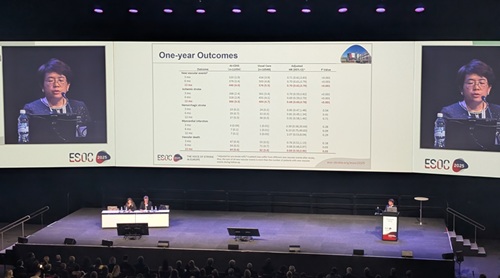
A large, multicentre, cluster-randomised trial in China—GOLDEN BRIDGE II—has demonstrated that integrating a clinical decision support system (CDSS) into routine acute ischaemic stroke care significantly improves both care quality and patient outcomes compared with usual care. Results from this study were presented for the first time by Chunjuan Wang (Beijing Tiantan Hospital, Beijing, China) at the 11th European Stroke Organisation Conference (ESOC; 21–23 May, Helsinki, Finland) earlier this week.
The study, which involved more than 21,600 patients across 77 hospitals, is said by researchers to be the first to show that artificial intelligence (AI)-driven support can reduce recurrent vascular events and all-cause mortality up to one year after stroke, and enhance adherence to evidence-based treatment protocols.
Xinmiao Zhang (Beijing Tiantan Hospital, Beijing, China), study chair, commented: “By harnessing AI to deliver rapid, evidence-based guidance, we’ve shown that decision support can move beyond theory into practice—improving both how we treat acute strokes and the lives of our patients.”
CDSS tools offering automated imaging analysis, stroke subtype classification, and guideline-based treatment recommendations, hold promise for standardising care and improving outcomes.
GOLDEN BRIDGE II was designed to test this hypothesis in a real-world, multicentre setting. From January 2021 to June 2023, 77 hospitals in China were cluster-randomised to either receive the stroke CDSS (n=38) or continue usual care (n=39). The stroke CDSS provided automated magnetic resonance imaging (MRI) lesion detection and lesion characteristics analysis; algorithmic classification of stroke aetiology; and real-time, guideline-based recommendations for secondary prevention.
A total of 21,603 patients with acute ischaemic stroke (median age, 67 years; 35.5% women) were enrolled, with 20,231 (95.7%) completing 12-month follow-up.
One of the key results from GOLDEN BRIDGE II was a reduction in new vascular events; at three months, the intervention group had a 2.9% rate versus 3.9% in controls (adjusted hazard ratio [HR], 0.71; p<0.001), as per the trial’s primary endpoint. And, at six months, rates were 3.4% versus 4.8% (HR, 0.7; p<0.001), and 4% versus 5.5% at 12 months (HR, 0.7; p<0.001).
The intervention was also associated with lower all-cause mortality. At six months, death had occurred in 2% of CDSS patients compared to 2.3% of controls (HR, 0.78; p=0.007), and 3% versus 3.5%, respectively, at 12 months (HR, 0.77; p<0.001).
Another key finding reported by the investigators was an overall improvement in quality of care, as patients at CDSS sites were more likely to receive a higher composite acute ischaemic stroke quality score compared to controls (91.4% vs 89.7%; odds ratio [OR], 1.26; p<0.001).
The GOLDEN BRIDGE II investigators ultimately conclude that their trial provides robust evidence that stroke CDSS integration into stroke workflows enhances treatment fidelity, and translates into meaningful reductions in recurrent stroke and mortality, further positing that these findings support wider adoption of AI-driven decision support to optimise acute stroke care and patient outcomes globally.












